Effect of Overheating on the Tensile Properties of Nickel-Based Superalloy GH4720Li
Abstract
:1. Introduction
2. Materials and Methods
2.1. Material
2.2. Experimental Methods
3. Results and Analysis
3.1. High-Temperature Tensile Test Results
3.2. High-Temperature Tensile Test Results after OEI-State Treatment
3.3. Effect of OEI-State Treatment on Precipitate Morphology
4. Conclusions
- After the GH4720Li alloy was overheated at different temperatures for 30 s and cooled to room temperature in air, its tensile properties changed dramatically after OEI treatment at 800 °C, with its tensile ductility reduced by more than 50%. Lowering the overheating temperature (700 °C) had little effect on the tensile properties of the material.
- The GH4720Li alloy’s microstructure changed significantly after OEI treatment. In the most stringent OEI treatment, the primary γ′ phase of the alloy rapidly dissolved. The accumulation of the tertiary γ′ phase led to numerous irreversible microcracks between the grains. These damage mechanisms significantly decreased the elongation at break of the alloy after OEI treatment, and multiple OEI treatments exacerbated this effect.
- As the GH4720Li alloy was subjected to multiple OEI treatments at 800 °C-700 MPa-30 s, the volume fraction of the primary γ′ phase continued to decrease, the average size continued to increase, and, at the same time, irreversible microcrack damage occurred between the grain boundaries. As a result, the ultimate tensile strength and yield strength of the GH4720Li alloy decreased, as did its tensile plasticity.
Author Contributions
Funding
Institutional Review Board Statement
Informed Consent Statement
Data Availability Statement
Conflicts of Interest
References
- Na, Y.S.; Park, N.K.; Reed, R.C. Sigma morphology and precipitation mechanism in Udimet 720Li. Scr. Mater. 2000, 43, 585–590. [Google Scholar] [CrossRef]
- Moshtaghi, M.; Abbasi, S.M. Effect of vacuum degree in VIM furnace on mechanical properties of Ni–Fe–Cr based alloy. Trans. Nonferrous Met. Soc. China 2012, 22, 2124–2130. [Google Scholar] [CrossRef]
- Yu, Q.; Yao, Z.; Dong, J.X. Deformation and recrystallization behavior of a coarse-grain, nickel-base superalloy Udimet720Li ingot material. Mater. Charact. 2015, 107, 398–410. [Google Scholar] [CrossRef]
- Ning, Y.; Wang, T.; Fu, M.; Li, M.; Wang, L.; Zhao, C. Competition between work-hardening effect and dynamic-softening behavior for processing as-cast GH4720Li superalloys with original dendrite microstructure during moderate-speed hot compression. Mater. Sci. Eng. A 2015, 642, 187–193. [Google Scholar] [CrossRef]
- Pang, H.; Hardy, M.; Hide, N.; Wilcock, I.; Henderson, M.; Reed, P. Comparison of fatigue crack propagation in nickel base superalloys RR1000 and Udimet 720Li. Mater. Sci. Technol. 2016, 32, 22–39. [Google Scholar] [CrossRef]
- Jackson, M.P.; Reed, R.C. Heat treatment of UDIMET 720Li: The effect of microstructure on properties. Mater. Sci. Eng. A 1999, 259, 85–97. [Google Scholar] [CrossRef]
- Chen, J.; Dong, J.; Zhang, M.; Yao, Z. Deformation mechanisms in a fine-grained Udimet 720LI nickel-base superalloy with high volume fractions of γ′ phases. Mater. Sci. Eng. A 2016, 673, 122–134. [Google Scholar] [CrossRef]
- Kan, Z.; Du, L.X.; Hu, J.; Weng, L. Influence of Microstructure on Mechanical Property of GH4720Li Alloy. J. Northeast. Univ. (Nat. Sci.) 2017, 38, 46–50. [Google Scholar]
- Kong, Y.S.; Cheepu, M.; Kim, D.G. Effects of heat treatment on the mechanical behavior of Udimet 720 nickel-based superalloy. J. Mater. Eng. Perform. 2022, 31, 8327–8333. [Google Scholar] [CrossRef]
- Utada, S.; Sasaki, R.; Reed, R.C.; Tang, Y.T. Overheating of Waspaloy: Effect of cooling rate on flow stress behavior. Mater. Des. 2022, 221, 110911. [Google Scholar] [CrossRef]
- Monajati, H.; Jahazi, M.; Bahrami, R.; Yue, S. The influence of heat treatment conditions on γ′ characteristics in Udimet® 720. Mater. Sci. Eng. A 2004, 373, 286–293. [Google Scholar] [CrossRef]
- Song, Y.D.; Ling, C.; Zhang, L.C. Research Progress on Hot Corrosion-Fatigue of Aero-engine and Gas Turbine Hot-Section Components. J. Nanjing Univ. Aeronaut. Astronaut. 2022, 54, 54. [Google Scholar]
- Zha, X.C.; Zhang, S.; Shu, J.Y.; Lu, Y.Q. Requirements of OEI Related Engine Airworthiness Verification. Aerosp. Power 2022, 28, 48–51. [Google Scholar]
- Cormier, J. Comportement en Fluage Anisotherme à Haute et très Haute Température du Superalliage Monocristallin MC2. Ph.D. Thesis, École Doctorale Sciences pour L’ingénieur et Aéronautique, Poitiers, France, 2006. [Google Scholar]
- Liu, F.; Chen, J.; Dong, J.; Zhang, M.; Yao, Z. The hot deformation behaviors of coarse, fine and mixed grain for Udimet 720Li superalloy. Mater. Sci. Eng. A 2016, 651, 102–115. [Google Scholar] [CrossRef]
- Rezende, M.C.; Araújo, L.; Gabriel, S.; Dille, J.; de Almeida, L.H. Oxidation assisted intergranular cracking under loading at dynamic strain aging temperatures in Inconel 718 superalloy. J. Alloys Compd. 2015, 643, S256–S259. [Google Scholar] [CrossRef]
- Németh, A.A.; Crudden, D.J.; Collins, D.M.; Armstrong, D.E.; Reed, R.C. Novel techniques to assess environmentally-assisted cracking in a nickel-based superalloy. In Proceedings of the Superalloys 2016: Proceedings of the 13th International Symposium of Superalloys, Seven Springs, PA, USA, 11–15 September 2016; Wiley: Hoboken, NJ, USA, 2016; pp. 801–810. [Google Scholar]
- Chiozzi, S.; Dattoma, V.; Nobile, R. Mechanical Behaviour of Udimet 720Li Superalloy. In Proceedings of the Experimental Analysis of Nano and Engineering Materials and Structures, Alexandroupolis, Greece, 1–6 July 2007; pp. 463–464. [Google Scholar]
- Gabb, T.P.; Telesman, J.; Banik, A.; McDevitt, E. Use of slow strain rate tensile testing to assess the ability of several superalloys to resist environmentally-assisted intergranular cracking. In Proceedings of the International Symposium on Superalloy 718 and Derivatives, Pittsburgh, PA, USA, 28 September–1 October 2014. [Google Scholar]
- Roy, A.K.; Venkatesh, A.; Marthandam, V.; Ghosh, A. Tensile deformation of a nickel-base alloy at elevated temperatures. J. Mater. Eng. Perform. 2008, 17, 607–611. [Google Scholar] [CrossRef]
- Gopinath, K.; Gogia, A.K.; Kamat, S.V.; Balamuralikrishnan, R.; Ramamurty, U. Tensile Properties of Ni-Based Superalloy 720Li: Temperature and Strain Rate Effects. Metall. Mater. Trans. A 2008, 39, 2340–2350. [Google Scholar] [CrossRef]
- Andersson, J.; Sjöberg, G.P.; Viskari, L.; Chaturvedi, M. Effects of different solution heat treatments on the hot ductility of superalloys: Part 3–Waspaloy. Mater. Sci. Technol. 2013, 29, 43–53. [Google Scholar] [CrossRef]
- Kozar, R.W.; Suzuki, A.; Milligan, W.W.; Schirra, J.J.; Savage, M.F.; Pollock, T.M. Strengthening Mechanisms in Polycrystalline Multimodal Nickel-Base Superalloys. Metall. Mater. Trans. A 2009, 40, 1588–1603. [Google Scholar] [CrossRef]
- Osada, T.; Nagashima, N.; Gu, Y.; Yuan, Y.; Yokokawa, T.; Harada, H. Factors contributing to the strength of a polycrystalline nickel–cobalt base superalloy. Scr. Mater. 2011, 64, 892–895. [Google Scholar] [CrossRef]
- E112-96; Standard Test Methods for Determining Average Grain Size. ASTM International: West Conshohocken, PA, USA, 2004.
- Vaunois, J.-R.; Cormier, J.; Villechaise, P.; Devaux, A.; Flageolet, B. Influence of both γ′ distribution and grain size on the tensile properties of UDIMET 720Li at room temperature. In Proceedings of the 7th International Symposiumon Superalloy, Pittsburgh, PA, USA, 10–13 October 2010; Volume 718. [Google Scholar]
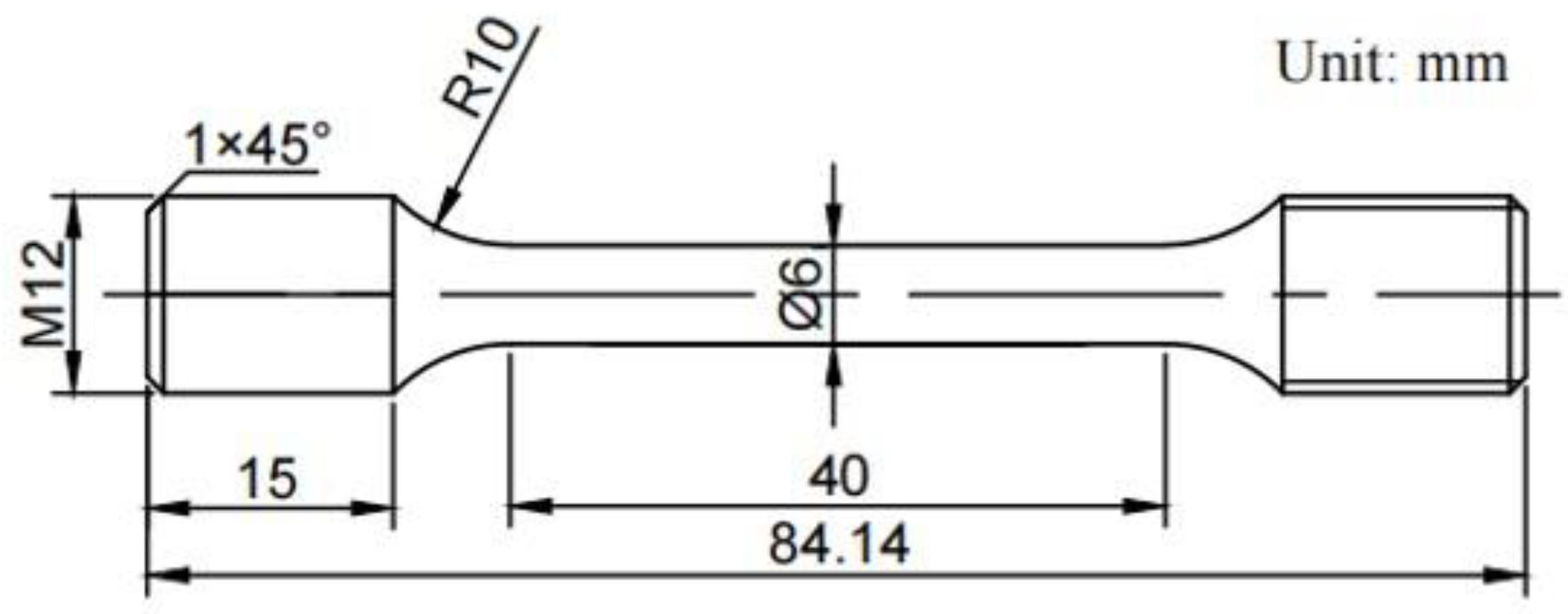

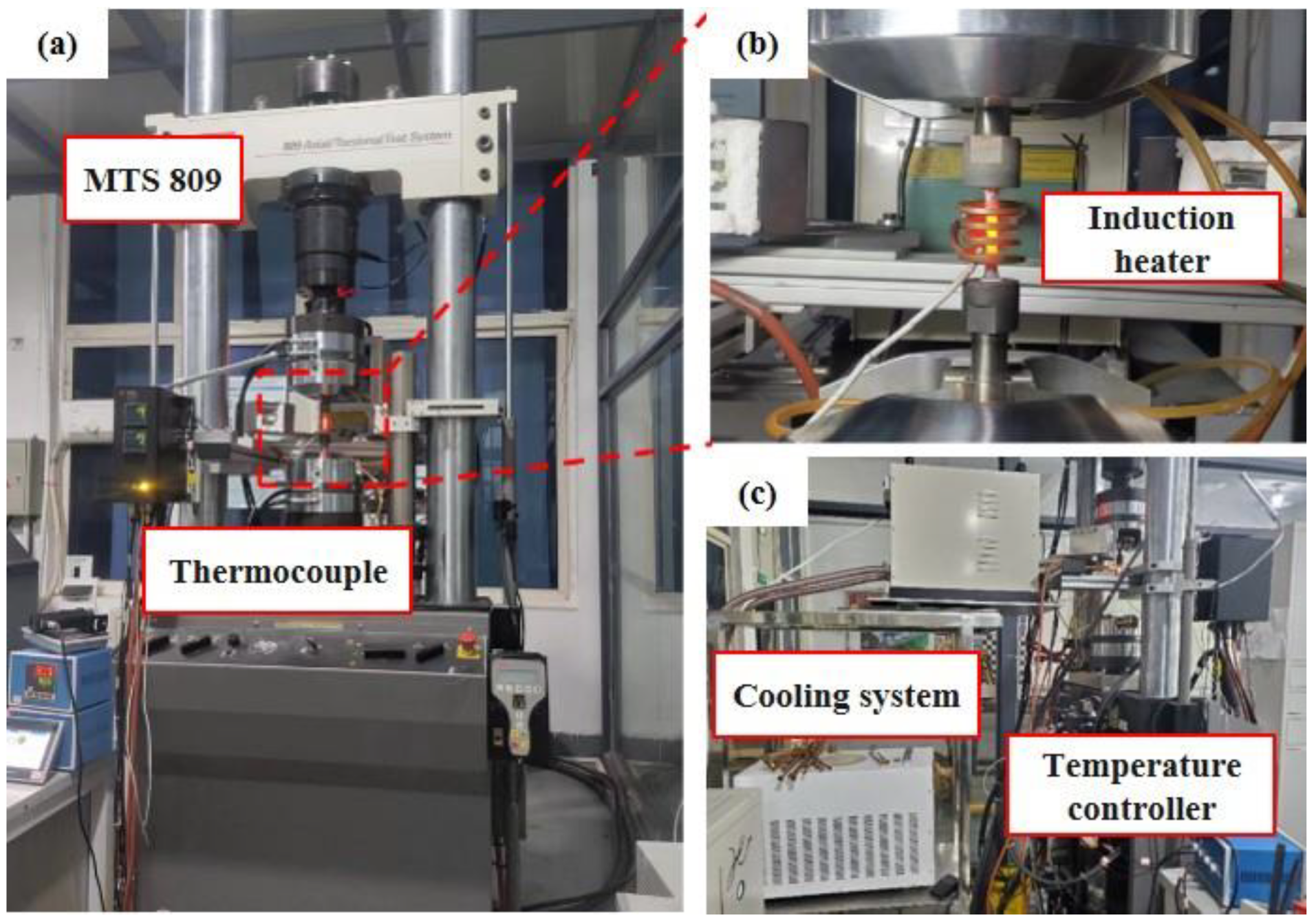


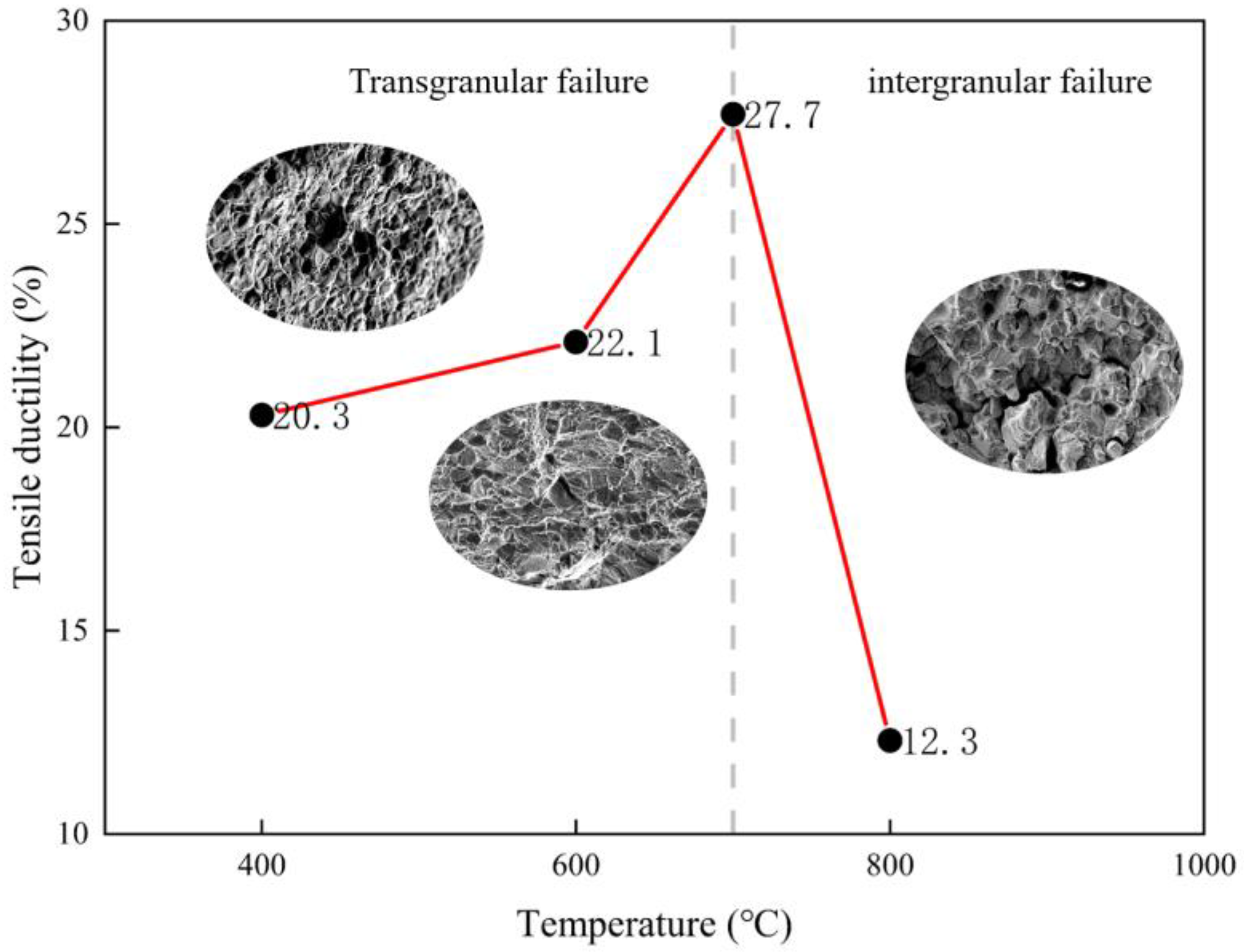

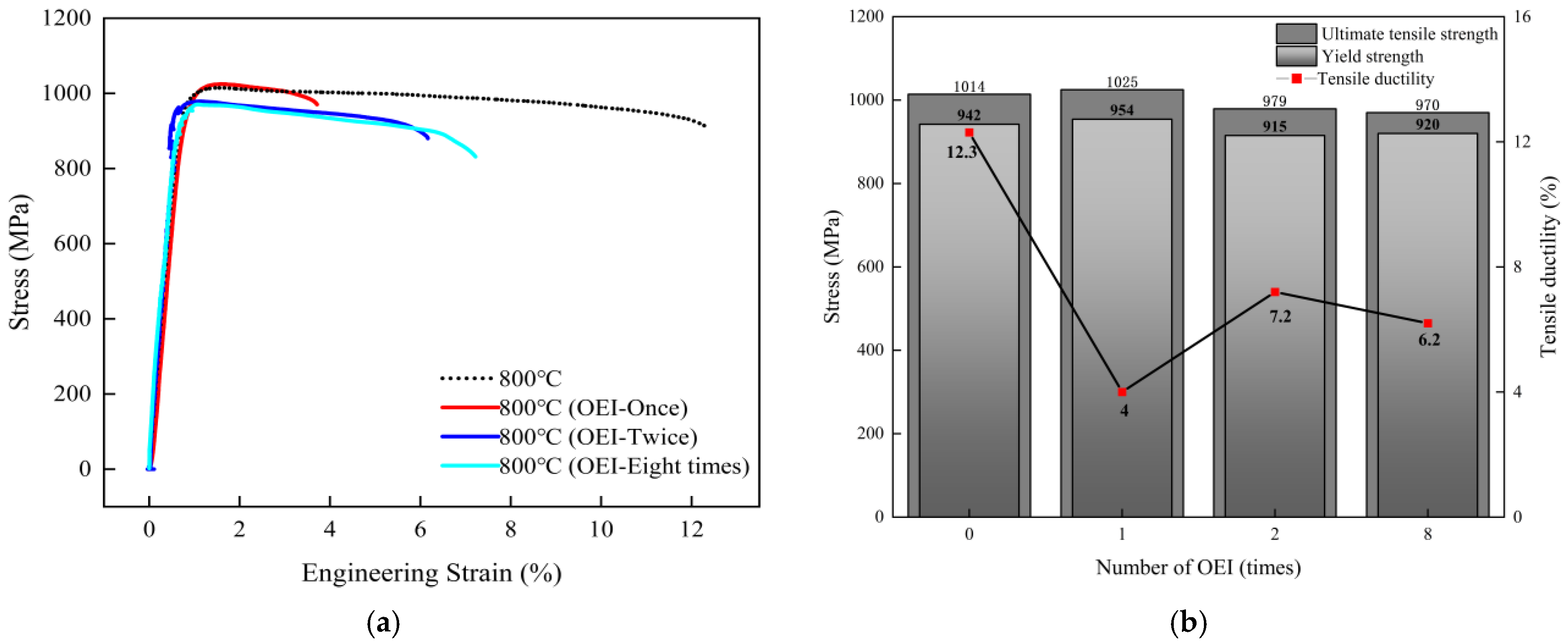

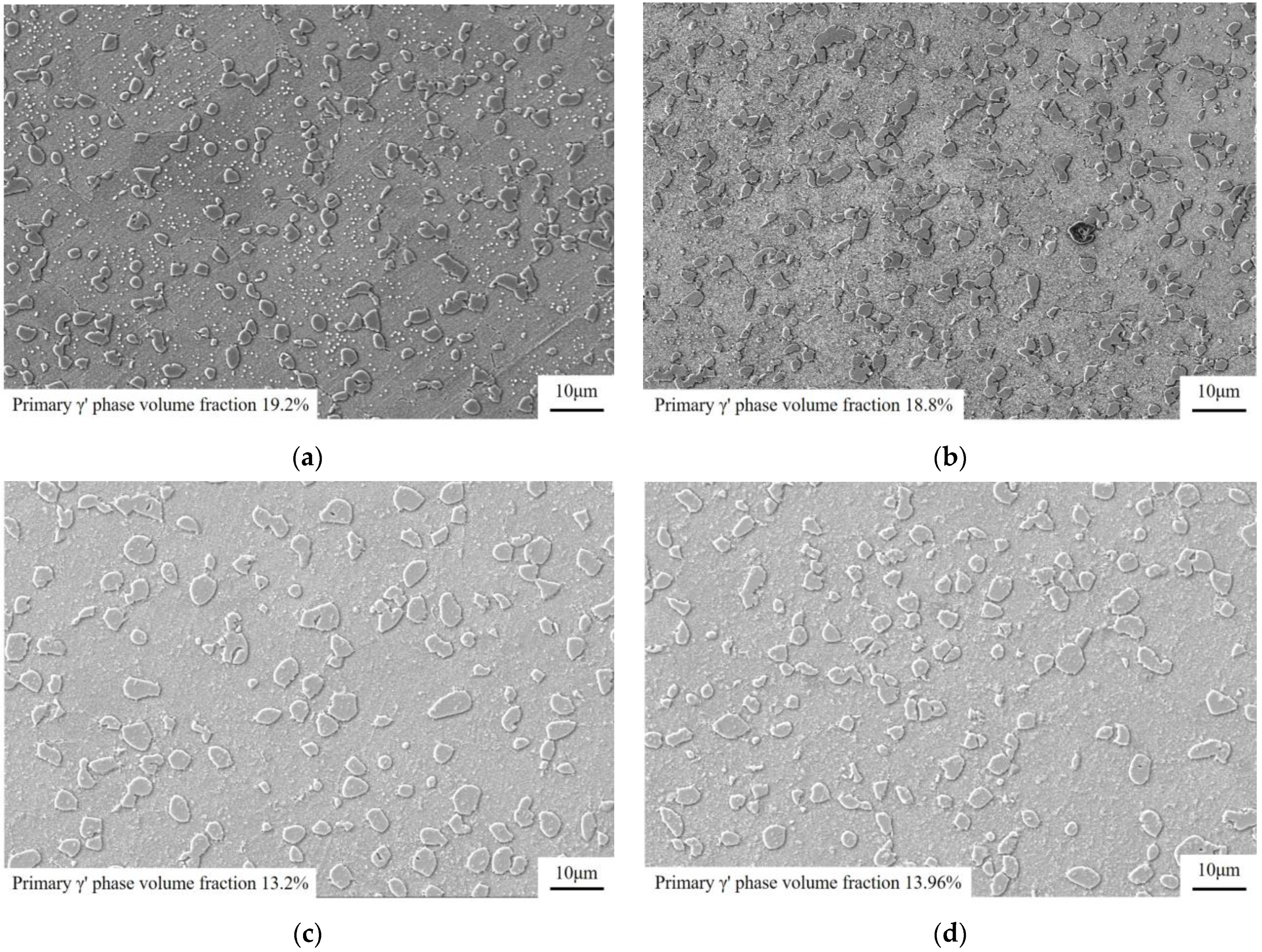




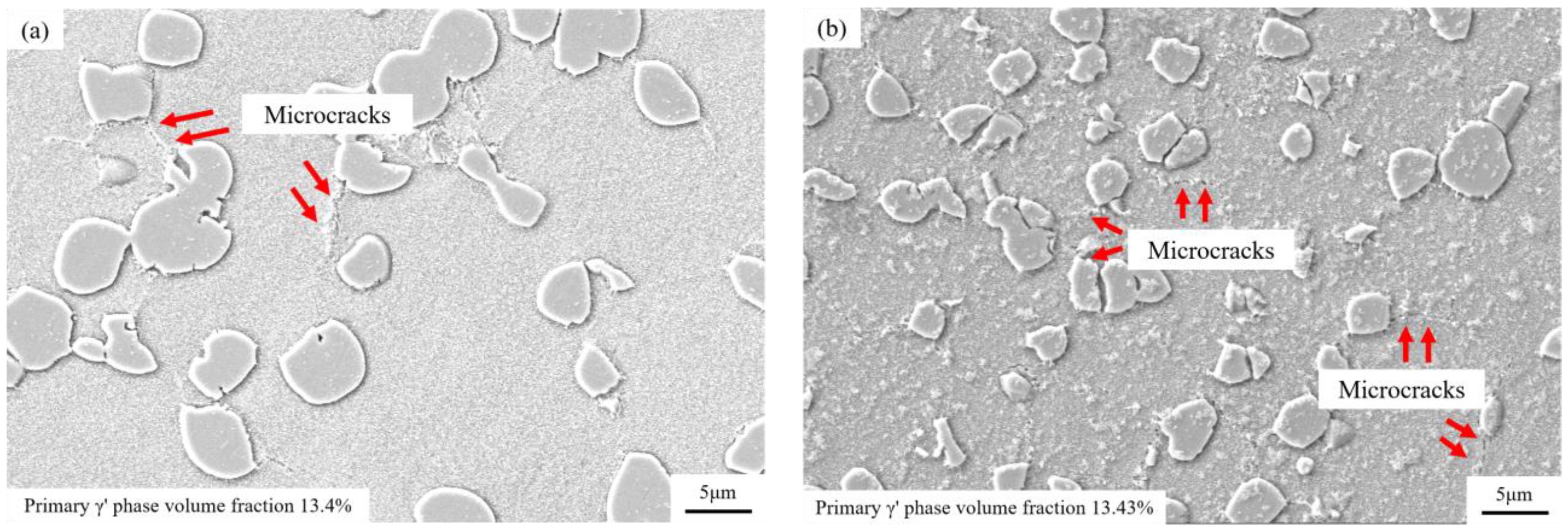

| Cr | Co | W | Mo | Al | Ti | C | B | Zr | Ni |
|---|---|---|---|---|---|---|---|---|---|
| 16 | 14.7 | 1.25 | 3 | 2.5 | 5 | 0.015 | 0.015 | 0.05 | margin |
| OEI Temperature | OEI Stress | Duration of Action | Number of OEI Stage | Heating Rate to the OEI Stage |
|---|---|---|---|---|
| 800 °C | 700 MPa | 30 s | 1 | 60 °C s−1 |
| 800 °C | 2 | |||
| 800 °C | 8 | |||
| 700 °C | 1 | |||
| 600 °C | 1 |
| OEI-Times | 0 | 1 | 2 | 8 |
|---|---|---|---|---|
| Primary γ′ volume fraction f/% | 13.4 | 13.43 | 11.8 | 10.1 |
| Primary γ′ grain size d/μm | 4.3 | 4.58 | 4.451 | 4.78 |
Disclaimer/Publisher’s Note: The statements, opinions and data contained in all publications are solely those of the individual author(s) and contributor(s) and not of MDPI and/or the editor(s). MDPI and/or the editor(s) disclaim responsibility for any injury to people or property resulting from any ideas, methods, instructions or products referred to in the content. |
© 2024 by the authors. Licensee MDPI, Basel, Switzerland. This article is an open access article distributed under the terms and conditions of the Creative Commons Attribution (CC BY) license (https://creativecommons.org/licenses/by/4.0/).
Share and Cite
Wang, A.; Liu, Z.; Cui, R.; Wu, Y.; Zhang, D.; Wang, X. Effect of Overheating on the Tensile Properties of Nickel-Based Superalloy GH4720Li. Materials 2024, 17, 2351. https://doi.org/10.3390/ma17102351
Wang A, Liu Z, Cui R, Wu Y, Zhang D, Wang X. Effect of Overheating on the Tensile Properties of Nickel-Based Superalloy GH4720Li. Materials. 2024; 17(10):2351. https://doi.org/10.3390/ma17102351
Chicago/Turabian StyleWang, Anqi, Zhicheng Liu, Ruoyao Cui, Yangyang Wu, Di Zhang, and Xiaogang Wang. 2024. "Effect of Overheating on the Tensile Properties of Nickel-Based Superalloy GH4720Li" Materials 17, no. 10: 2351. https://doi.org/10.3390/ma17102351




